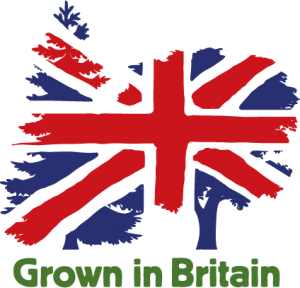Keeping Wood Local: The Grown in Britain Licencing Scheme

Charlie Law April 2015 Responsible Sourcing
We are probably all aware of the FSC tick logo, which has been around for over 20 years now, and many will also be aware of PEFC. These timber ‘chain of custody’ schemes are an excellent way to confirm that your timber or timber product is from a legal and sustainable source, but they do not always tell you where it came from. However there is now a Grown in Britain licencing scheme that sits alongside these standards which can confirm your timber is grown in Britain, in a similar way to the Red Tractor scheme confirms the source of your food.
Grown in Britain aims to create a forest culture in the UK, and this means improving the connection between the general public and the role their local woodlands can play in a sustainable circular economy. However, there is work to do.
55% of people still believe that cutting down forests and woodland, and replanting with new trees, makes climate change worse.[i] In actual fact, sustainable forest management is good for the environment. It is actually better to cut down old trees and plant new ones, as growing trees absorb more CO2 than mature trees. It is also good for biodiversity – by thinning woods in a managed way, more light reaches the forest floor, allowing young trees and new wildlife habitats to develop.
Also only 42% of people agreed that using wood for building instead of concrete or steel was better for climate change. In fact, building with timber significantly reduces the embodied carbon of a project (the carbon used to manufacture products and transport them to site). Wood for Good’s Build with Carbon campaign has some innovative graphics that explain the benefits of using timber for construction, and hopefully this will help change the public’s perception.
There is also now even more pressure on contractors to source products locally, with building certification schemes such as LEED setting a target for materials to come from within 500 miles, and it is only a matter of time before BREEAM probably follows suit. Many clients are also setting their own specific targets.
So how do you know if your timber is managed sustainably and locally sourced? Well up until recently, unless you knew the local saw mill, this has been difficult. However the launch of the new Grown in Britain licencing scheme, which we helped draft, now means that you can be sure that your timber has been grown in Britain.
It all starts with a Grown in Britain licenced woodland, which in most cases may already be FSC and/or PEFC certified, however the minimum requirement is that the woodland must have an approved UKFS compliant management plan. The advantage of the Grown in Britain scheme is that any additional cost to the woodland owner is small, with the fee being waived altogether for woodlands of less than 20 hectares. The Forestry Commission and The Crown Estate have already licenced all of their woodlands, accounting for over 50% of all harvested softwood in the UK.
Once the logs leave the woodland they are tracked through the various processes in a similar way to the existing chain of custody schemes, by identifying Grown in Britain timber on the delivery tickets and invoices. For example BSW, the largest sawmilling business in the UK producing over 1 million m3 of sawn timber, can now supply Grown in Britain licenced timber through the supply chain. The final product, such as a sheet of OSB or a piece of furniture, can also display the Grown in Britain logo on the product.
This traceability is important as customers, especially building clients, need evidence that their product or building contains the material they specify. Most UK Contractors Group members have already signed up to a Grown in Britain preference statement, and large clients, such as British Land and HS2 have similar statements.
Therefore, if you want to be sure that your timber is locally sourced, and support the UK economy, make sure you specify Grown in Britain timber in addition to your normal FSC/PEFC requirements. And if you are a woodland owner, or part of the timber supply chain, make sure you apply for a Grown in Britain licence so that the construction industry can continue to work with you.
For more information see our Grown in Britain Licence page or Contact Us if you need any help in setting up your strategy or systems . For more information on Building with carbon, and to see how woodland management and building with timber benefits climate change, visit the Wood for Good website.
[i] Forestry Commission Forestry Statistics 2014
